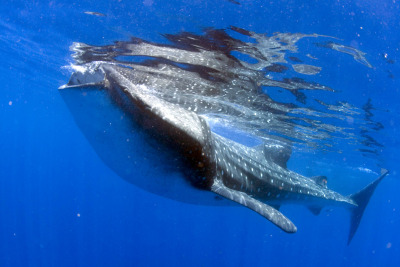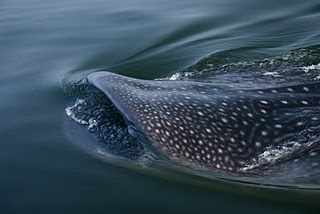Its easy to get discouraged about the plight of marine ecosystems and the future of all those incredible marine species that we love so much. This is especially so of late, with all the bad news about the oil spill in the northern Gulf of Mexico and the impacts that it may well have on several habitats. Consider this post, then, as your good news story for the week. I am here to tell you that there is still amazing stuff to see in the ocean. Incredible stuff. Stuff that will blow your mind. I can tell you this with supreme confidence, because for the last two days, that’s exactly what I have been seeing. As part of the research program at Georgia Aquarium, I am with colleagues in Quintana Roo, Mexico, studying whale sharks and other species that live in the azure waters of the Yucatan peninsula. Jeff Reid, who is the aquarium’s dive safety officer, is here and our main colleague in Mexico is Rafael de la Parra of
Project Domino, who has been working on whale sharks and other marine species in the area for many years. This is a remarkable part of the world, with a lot of great terrestrial activities (can you say Cenotes, anyone? No? How about Mayan ruins?), exceeded only by the marine life, which is truly spectacular.
Yesterday Jeff and Raffa and I spent the day boating around the northeastern tip of the Yucatan along with videographer Jeronimo. Now, when you’re on a boat, you can only see a small strip of ocean either side of the vessel, and yet over the course of the day we saw lots of mobula (devil rays), turtles, flying fish, manta rays, spotted dolphins and whale sharks. We snorkeled alongside some of these animals and, in the case of whale sharks and mantas, took samples of their food for later analysis. They dine on the rich plankton soup of this tropical upwelling area, much of which consisted of fish eggs, which hints at other fish species – yet unseen – taking advantage of the plankton to start their next generation by spawning in the surface waters. Snorkeling next to a whale shark in the natural setting was a special thrill; I’ve been lucky enough to work with the animals in the collection at Georgia Aquarium since 2006, but this was my first encounter with them in the wild. Except for the slightly different “faces” (we do get to know our animals pretty well) and the parasitic copepods visible on the fins of the wild animal, it could have easily been the very same sharks Jeff and I have been working with in Atlanta.
Today, Jeff and Raffa and I joined Lilia (from the Mexican department of protected areas CONANP) and pilot Diego for an aerial survey of the waters around the northeastern tip of the Yucatan. In contrast to the boat, you can’t get in the water from a plane (its not advisable anyway), but you can see a whole lot more at once and cover a much greater area in a relatively shorter time. From the air, lots of sharks, cownosed rays, manta, dolphins, fish schools and whale sharks were all visible, and I am told that flamingos and manatees can be seen at other times too. The manta rays, which numbered in the hundreds, were especially impressive and included at least two species (see my post about taxonomy of mantas). The sheer number of cownosed rays, called chuchas in the local slang, was staggering (muchas chuchas, if you will). They formed huge schools that looked for all the world like the rafts of sargassum weed that accumulate on the wind-lines at the water’s surface offshore. Many of the turtles and mobula seemed to be in the mood for love; most turtles were in pairs (or a pair being followed by other hopeful males), whereas the mobula followed each other in lazy tandems, their wingtips breaking the surface with every stroke. Whale sharks were also there – lots of them – with their attendant flotilla of tourist boats and tiny orange specks of snorkelers in life-vests, doing their best (and largely failing) to keep up with the gentle giants.
When you have experiences such as those I have shared with my colleagues over the last two days, you are reminded why we do this stuff in the first place. Its not just for the papers, or the salary or the glory of new discovery (yeah, right!), its for those moments working with animals when you and a colleague become friends because you shared an experience of the oceans that most folks will never have. We should seek to share and recreate those moments with everyone we can, whether its in an aquarium or on the open ocean. I am pretty sure that if we could all do that, then public empathy for the plight of the oceans would skyrocket, and many of the threats that face them would be addressed quick smart.
 Monday, September 27, 2010 at 8:02AM
Monday, September 27, 2010 at 8:02AM 










